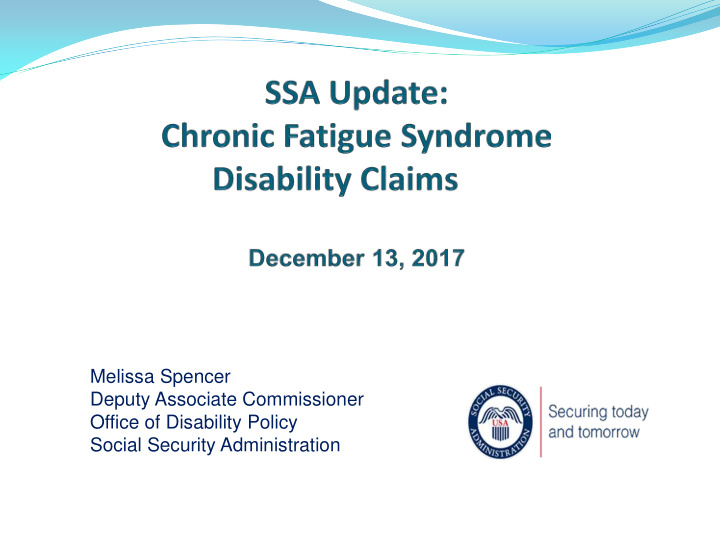



ministration zyxwvutsrqponmlkjihgfedcbaZYXWVUTSRQPONMLKJIHGFEDCBA Melissa Spencer Deputy Associate Commissioner Office of Disability Policy Social Security Administration
SSA Disability Overview • SSA administers two disability programs: o Social Security Disability Insurance (SSDI) o Supplemental Security Income (SSI) • We define disability as: o The inability to engage in any substantial gainful activity (e.g., to earn $1,170 per month) o Due to any severe medically determinable physical or mental impairment o That has lasted, or is expected to last, for at least one year or expected to result in death 2
Process for Determining Disability 5-Step Sequential Evaluation Process: Step 1: Is the person currently working? (If so, not eligible) Step 2: Is there a severe impairment? Step 3: Does the impairment (or combination of impairments) meet established medical criteria (i.e., a Medical Listing)? The Listings describes for each major body system impairments that we consider to o be severe enough to prevent an individual from doing any gainful activity, regardless of his or her age, education, or work experience Step 4: Can the person perform their previous work? Step 5: Does the person have the functional ability to work at the level of substantial gainful activity (SGA) in any type of work that exists in the national economy at sufficient number considering their age, education, and previous work This is primarily a decision based on how well a person can function given their o medical impairment(s) in conjunction with their age, education, and work experience 3
Evidence Needed to Make a Determination • When a person files for disability, we obtain information (evidence) from medical providers who care(d) for the applicant, including diagnoses, test results, imaging reports, and treatment notes • If we cannot obtain sufficient evidence, we may arrange and pay for a consultative medical examination (CE) • This information is used to establish that the person has a severe impairment (Step 2) • Once a severe impairment is established, this information from other medical and non-medical (e.g., family, schools and employers) sources, is used to make disability determinations (Step 3-5) 4
SSA Disability Overview - Conclusion Once it is established that a person is not working (Step 1) and has a severe impairment (Step 2), decisions are made on the basis of: o Medical Criteria (primarily Step 3) o Functional Abilities (primarily Step 4 & 5) Keeping our Medical Listings, vocational policies, and processes current with medical practice, healthcare delivery, and technological advances helps to ensure accurate and consistent disability determinations 5
SSA’s Data on Chronic Fatigue Syndrome Who applies for disability and what happens with the applications? Data was: o Prepared by SSA/DCRDP/ODP/ODPMI o Prepared in November 2017 o From data source: 831 Files 6
SSA Processed Chronic Fatigue Syndrome Cases Initial Level, FY 2001-2017 2,500 3 0 % Allowance Rate (Allowances/Determinations) Number of Determinations and Allowances 2 5 % 2,000 2 0 % 1,500 1 5 % 1,000 10 % 500 5 % 0 0 % 2001 2002 2003 2004 2005 2006 2007 2008 2009 2010 2011 2012 2013 2014 2015 2016 20 17 Fiscal Year Allowances Determinations Allowance Rate
SSA Processed Chronic Fatigue Syndrome Cases Reconsideration Level, FY 2001-2017 900 18 % 800 16 % Allowance Rate (Allowances/Determinations) Number of Determinations and Allowances 700 14 % 600 12 % 500 10 % 400 8 % 300 6 % 200 4 % 100 2 % 0 0 % 2001 2002 2003 2004 2005 2006 2007 2008 2009 2010 2011 2012 2013 2014 2015 2016 2017 Fiscal Year Allowances Determinations Allowance Rate
SSA Processed Chronic Fatigue Syndrome Cases Administrative Law Judges, FY 2008 - FY 2017 1,200 85% Allowance Rate (Allowances/Determinations) 1,000 Number of Determinations and Allowances 80% 800 75% 600 70% 400 65% 200 0 60% 2008 2009 2010 2011 2012 2013 2014 2015 2016 2017 Fiscal Year Favorable Decisions Decisions Allowance Rate
Chronic Fatigue Syndrome Initial Determinations and Allowances by Secondary Impairment, FY 2001 - FY 2017 0 1,000 2,000 3,000 4,000 5,000 6,000 7,000 Affective / Mood Disorders None Other (155 Impairments each less than 1% of total determinations) Disorders of the Back Anxiety Related Disorders Osteoarthritis / Allied Disorders Disorders of Muscle, Ligament and Fascia Migraine Obesity Essential Hypertension Fibromyalgia Organic Mental Disorders Asthma Diabetes Mellitus Other and Unspecified Arthropathies Other Disorders of the Gastrointestinal System All Disorders of the Thyroid Gland
Questions and Answers Any Questions? Thank you 11
Recommend
More recommend